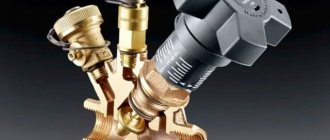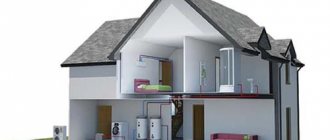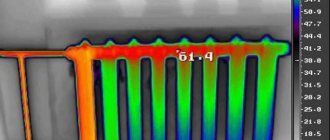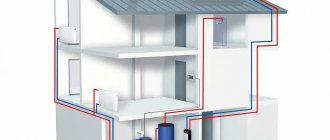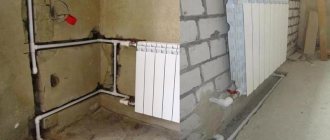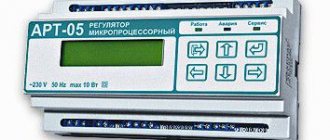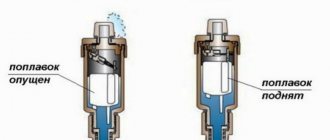It sounds confusing, but in reality everything is very simple: where is the supply and return in the heating system
The comfort of the family in winter will depend on how efficiently the heating system in the house operates .
If the batteries heat up poorly, it is necessary to eliminate the malfunction, and for this it is important to know how heating works in general. Water heating of space is a heat source and coolant, which is distributed through radiators . Supply and return are present in one- and two-pipe systems. In the second, there is no clear distribution; the pipe is conventionally divided in half.
The boiler is working, but the radiators are not heating, why is there cold return in the heating system?
The heating system is a complex structure consisting of several elements combined into one circuit and put into operation through a chain reaction.
What is return in a heating system?
The return is a coolant located inside the heating system. During operation, it passes through all heating devices and gives off heat to them. Then, already cooled, the coolant returns to the boiler, where it is heated and begins a new cycle.
Photo 1. Heating diagram with a circulation pump and expansion tank. The arrows show the movement of the coolant.
Both ordinary water and antifreeze act as a coolant. It is put into operation either naturally (under the influence of gravity) or forcibly (using a pump).
Causes of problems with return flow in the batteries of a private or apartment building
- insufficient water pressure in the system;
- small section of the pipe through which the coolant passes;
- incorrect installation;
- airiness or contamination of the system.
If a problem with cold return occurs in an apartment, then the first thing you should pay attention to is the pressure. This is especially true for rooms on the upper floors
The fact is that the principle of operation of the return flow is to quickly and continuously circulate liquid through the system. And if its speed drops, then the coolant will not have time to push out cold water and the batteries will not heat up.
The main reason for interruptions in the operation of the heating system in a private home is incorrect installation. Most often this happens when installation is carried out without the participation of specialists. Being incompetent in this matter, it is quite easy to confuse the supply and return pipes or choose pipes of the wrong size.
Troubleshooting methods. Why is cleaning necessary?
To understand exactly how to solve a problem, you first need to establish its source. If the batteries become cold due to insufficient water circulation, installing a special pump will help. It will regularly push water into the circuit under a certain pressure, thereby preventing the system from stopping or slowing down.
If the reason is that the pipes are clogged, then they simply need to be cleaned. You can do this in several ways:
- using a water-pulsating mixture;
- using biological products;
- by means of pneumatic hydraulic shock.
In the event of a malfunction resulting from improper installation of the equipment, contact a specialist. A qualified specialist will certainly understand the problem and eliminate all problems. In addition, he will give practical advice and recommendations on the care and operation of the system.
Useful video
Check out the video, which talks about one of the possible problems with the return flow - battery contamination.
What problems arise in the apartment due to cold return
Firstly, the batteries in this case do not heat up properly, or even do not work at all. Accordingly, the room itself becomes cold, which is certainly not encouraging.
This entails the accumulation of condensate on the walls of the boiler, which begins to react with carbon dioxide released from fuel combustion. The consequence of this process is the formation of acid, which corrodes the walls of the boiler, thereby destroying it.
To live without fires and explosions: how to ground a gas boiler in a private house with your own hands?
What is needed to connect a gas boiler to a gas source?
Are the pipes cracking angrily and not heating well? It's time to flush the gas boiler and its heat exchanger
Requires extreme caution! Principles for replacing a gas boiler in a private house
Fine-tuning the heating system, accessible to everyone: how to connect a room thermostat to a gas boiler
You can save money, just be careful: do-it-yourself instructions for repairing a gas boiler
This is interesting: How to bend drywall for an arch with your own hands at home: read in detail
Where is the return route?
In short, the heating circuit consists of several important elements : a heating boiler, batteries and an expansion tank. In order for heat to flow through radiators, a coolant is needed: water or antifreeze . If the circuit is constructed correctly, the coolant heats up in the boiler, rises through the pipes, increasing its volume, and all excess ends up in the expansion tank.
Based on the fact that the batteries are filled with liquid, hot water displaces cold water , which, in turn, enters the boiler again for subsequent heating. Gradually the water temperature increases and reaches the desired temperature. circulation can be natural or gravitational , carried out using pumps.
Based on this, the return can be considered a coolant that has passed through the entire circuit, giving off heat, and, already cooled, returned to the boiler for subsequent heating.
What to do if the bottom of the battery is colder than the top?
If the battery is hot on top and cold on the bottom, it is not functioning properly. In this case, diagnostics are required not only by the battery itself, but also by the entire heating system. The cause of the problem may lie in recent work on the heating system and replacement of the radiator. As a rule, the “hot top – cold bottom” problem appears due to an air lock (99% of cases) or a clogged radiator valve (a consequence of improper start-up of the system).
This problem is solved in two ways. You can remove the air lock using a Mayevsky tap or a bleeder. First of all, turn off the coolant supply to the radiator and leave the return line open. Open the drain, wait until the air comes out, close the drain and open the coolant supply. As a rule, this is enough.
If this method does not work, and we are talking about an apartment building, it is better to call a specialist. For private houses there is another option. First you need to turn off the heating supply, open the drain at the highest point of the system and use back pressure to squeeze out all the air.
Each heating system may have its own characteristics, and therefore there is a high probability of atypical problems arising. These include incorrectly selected pipe diameters, incorrect coolant distribution, poor throughput, lack of pressure, problems with the circulation pump or expansion tank. In any case, only a specialist can fully understand all the nuances, so in case of difficulties in solving the problem, it is better to seek help.
The heating system is a complex structure consisting of several elements combined into one circuit and put into operation through a chain reaction.
But it happens that the system fails and the water in the batteries becomes cold. The reason for this may be problems with the return line.
Differences between them
The difference between the described concepts is as follows:
- The supply is a coolant that flows through the radiators from the heat source.
- The return is a liquid that has passed through the entire circuit, and cooled down again to the heat source for subsequent heating. Therefore, occurs at the output .
- The difference is in temperature: the return is colder .
- The difference is in the installation. The water line that is attached to the top of the battery is the supply. What is attached to the bottom is the return line.
Important! Some tips need to be followed. The entire system must be completely filled with water or antifreeze . Maintaining fluid speed, circulation and pressure is equally important.
Temperature difference across radiators
The temperature difference should be 30 °C . In this case, the batteries will feel approximately the same to the touch . It is important to ensure that the difference in these values is not too large.
Photo 2. Heating diagram for 6 radiators: changes in flow and return temperatures on each of them are indicated.
Why do batteries in a private house not warm up well?
Just as in the case of a high-rise building, there may be several reasons for the poor performance of heating batteries in a private house.
Reason 1: problems in the hydraulics of the heating system
The most common reason why radiators remain cold is due to the hydraulics of the heating system. In this case, one of the heating branches is working properly, and the second is intermittent. This picture is typical for a new heating system or when adding radiators to an existing one. If the hydraulics are incorrectly calculated, and in particular the diameters and lengths of pipes, some batteries may simply not heat up. You can adjust the hydraulics using special taps.
Reason 2: single-pipe heating system
In many private homes there are single-pipe heating systems. In such a system, batteries remote from the boiler often heat much worse than those nearby. This does not mean that there are problems; this is the nature of the operation of a single-pipe system. The only solution here can only be to replace the system with a two-pipe one.
Reason 3: boiler malfunction
The batteries may not warm up due to malfunctions in boilers with built-in automation, pumps and sensors, which is a typical problem for autonomous heating systems. In this case, you must contact a specialist who works with such equipment directly.
Comparison results
Summing up, it becomes clear that a single-pipe distribution system with a return has the greatest prospects , especially for multi-storey buildings. Ease of installation, low cost and a small number of communications still have an advantage over a two-pipe with supply.
However, do not forget that using a two-pipe circuit, it is possible to regulate the heating temperature for each device separately.
One-pipe and two-pipe systems: comparison
Single-pipe systems, unlike two-pipe systems, do not have return risers. The coolant from the boiler, under the influence of circulation pressure or a pump, enters the upper heating devices. Cooling down, it returns back to the supply riser and goes down. The radiators below receive a mixture of coolant from the riser and from the upper radiators. Passing through all radiators and other heat consumers, the coolant returns again to the boiler, where the process is repeated again. The temperature of the coolant decreases as it passes in a circle, and therefore the lower the radiator is, the larger the heating surface should be.
Single-pipe and two-pipe heating systems.
For single-pipe systems there are 2 schemes. This is a flow and mixed scheme. The flow circuit has a peculiarity - the complete absence of jumpers between the supply and the outlet from the radiator. These schemes are almost never used when installing heating systems due to their impracticality. One battery breaks, and you need to turn off the riser, because there is no way to bypass the coolant. The advantage of single-pipe systems is the lower cost of building materials and ease of installation. Installation of single-pipe systems requires overhead wiring.
A two-pipe heating system can be used in any house: multi-story, single-story, etc. A two-pipe heating system is easy to implement with conventional circulation, since its configuration makes it possible to organize the circulation pressure; do not forget that the boiler must be installed below the level of the radiators. You can organize a heating system with forced circulation by simply installing a circulation pump in the circuit.
If it is possible to implement a ring circuit, then we need to do it. A two-pipe system usually needs to be installed where there are difficulties with gas, power outages, etc. For this system, a solid fuel boiler and pipes with a larger diameter are sufficient. Brought firewood or coal, and you don’t have to worry about frost.
How to find the supply and return pipelines for heating an apartment
Why is it necessary?
It is important for every apartment owner to know where the central heating input is located. Because, if a coolant leak occurs on any section of the pipeline or radiators, you need to react quickly and turn off the shut-off valves at the heating inlet to the apartment, in order to avoid flooding your apartment and the apartments of your neighbors below you. Since the pressure in centralized heating systems of apartment buildings is 3-5 Bar (atmospheres), the slightest leak will quickly turn into a deep river of boiling water (the temperature of the heating system varies from 40 to 90 °C).
Depending on the characteristics of the intra-house heating system, the input of thermal energy into the apartment may be located:
- directly in the apartment itself, in which case all that remains is to find out where the supply is and where the return is.
- in the heating niche located in the corridor on the floor where the apartment is located;
- in the heating niche located in the corridor 1 floor below the apartment;
- in the heating niche located in the corridor 1 floor above the apartment;
We will consider cases 2-4 in more detail below.
If each of the apartments has its own heating niche located near/under/above the entrance to the apartment, then all that remains is to find out where the supply is and where the return is.
In cases where we are dealing with combined heating niches (1 niche for the entire floor, 1 niche for every 2-4 apartments), a seemingly easy task can turn out to be a serious challenge. Everything is decided by chance. The following options are possible:
1. Numbering – trust, but verify!
If builders or operating organizations have numbered the outlets from the heating system comb, there is a possibility that your apartment number and the outlet number will match, and the search process will come to its logical conclusion. However, as the famous proverb said, “Trust, but verify!” How to do this is described below in this article.
2. The pipes do not intersect.
Builders often follow this rule when installing heating systems. Based on it, you can conduct a visual analysis of the direction of laying pipelines and find your pipes. However, in our country everything is possible and both written and unwritten rules, as well as any elementary logic and rationality, can be violated. So, if you want to be sure of something, check it yourself.
3. Plans and drawings do not correspond to harsh reality.
Armed with a floor-by-floor layout diagram of heating networks and engineering drawings, you can also get into trouble. Due to the fact that there is often a big difference between the project and the actual execution, it begins with the developer’s banal desire to save money and ends with the arbitrariness of the builders. So, if you want to be sure of something, check it yourself.
4. Clinical cases.
Sometimes you can simply encounter clinical cases of general negligence and irresponsibility, when, in the process of research, it is revealed that your incoming and outgoing pipes are not located symmetrically one below the other, but are located at different poles of the comb. That is, for example, your incoming pipe on the comb is the 1st on the left, and the outgoing pipe is the 2nd on the right.
Let's move directly to the methods of searching for the pipelines we need in the heating niche of the apartment located on the floor/above/below it.
All methods of searching for heating system pipes that lead to your home can be divided into two periods:
1) Autumn-spring period of operation of the centralized heating system.
Distinctive features of the heating system
The biggest advantage is electrical independence, and the disadvantage is the pipes, which have a large diameter and are routed at an angle.
Compared to the two-pipe option, there are quite a few advantages:
- pipes can be diverted to the “warm floor” system or heating radiators can be connected;
- it can be carried out regardless of the layout of the room;
- it covers the entire perimeter with a closed ring;
- it is less material-intensive and has a lower cost.
During use, difficulties may sometimes arise with circulation through the pipes, but this is easily solved by installing pump equipment. It produces proper circulation of coolant through the pipes.
A vertical single-pipe circuit is a popular example of wiring in apartment buildings.
Single-pipe heating system with pump.
But horizontal is used mainly for heating large rooms and is used very rarely in private buildings (mainly in small one-story houses). Here the supply pipe bypasses the heating devices, which are on the same level. The water in each radiator cools down and, approaching the last heating devices, becomes significantly cooled. This scheme will help reduce installation and piping costs, but has two disadvantages.
Firstly, this is a problem with heat regulation in any heating device. You cannot increase heat transfer, reduce it, or turn off the radiator. In installation practice, there is a jumper - a bypass, which allows you to turn off the radiator without turning off the system. Heating of the room is carried out indirectly through a riser or supply pipes. Another disadvantage is that you need to use radiators of various sizes. In order for the heat transfer to be the same, the first heating device must be very small, and the last one must be large. A horizontal single-pipe heating circuit is also used.
How to determine where the heating supply is?
Two rooms on the 4th floor. In the first, the riser goes through the radiator to the 5th floor, there it spreads into the next room and goes down through the radiator, i.e. this is one circuit. In 1 room there are 10 bimetal sections. The supply pipes are hot, the battery is heated by the triangle. From about section 5, the temperature at the bottom of the radiator begins to drop. The upper manifold is all hot. In the second room there are 8 bimetal sections. The battery is all uniformly hot. I suspect that in an unheated battery the supply comes from below? Selfish question, I’m going to insert a tube into the supply to lengthen the flow.
2Mishutk IMHO, the most accurate diagnosis can be made by visiting the basement, where everything is.
2Mishutk TOUCH THE RISERS THAT ARE HOT AND SERVED
No basement. In terms of riser temperature, both are subjectively the same. Just poke it with a thermometer.
I thought about shutting off the battery (there is a bypass), letting it cool, then opening it slightly and feeling where it starts to warm up.
or catch the Zhekovsky plumber. he knows for sure.
Mishutk wrote: In terms of riser temperature, both are subjectively the same. Just poke it with a thermometer.
yes, your penultimate floor is a little complicated, but on the first or second, if you touch it with your neighbors, it will immediately become clear
You can take (buy, ask for) a digital multimeter (and sensor) and measure the temperature. Many multimeters have a temperature measurement function. It is better to do this in cold weather, because... The temperature difference even in cold weather is not very big. The position of the sensor relative to the pipe should be the same in the measurements. There should be several measurements.
2Akim And you can miss with it in this situation, we have a TC - 3M, contact digital, old stuff, of course, in such a situation not the best assistant.
2Suever In order not to miss, you must comply with the following conditions:
- sensor relative to the pipe in one position (or isolate the sensor from air flows)
- for accuracy, take 10 measurements, min. and max. discard the values and find the average (this is like the maximum program)
2Akim This is not all, clean the pipe with a file, down to the metal, lubricate the surface with Vaseline and apply a temperature probe, only in the basement it will be simple, quick and 100%, and believe me, there are many ways to get there.
Here, on this forum, the simplest method has already been proposed, without instruments, by touch. It couldn't be simpler.
To do this, it is necessary to stop the movement of water in the battery and allow it to cool. Such a tap for every battery is highly desirable. Then turn on the water supply and keep your hands on both pipes. Two hands are enough. The pipe that starts to heat up first. will point you in the direction of the water.
Grandfather simply wrote: To do this, you need to stop the movement of water in the battery and let it cool. Such a tap for every battery is highly desirable. Then turn on the water supply and keep your hands on both pipes. Two hands are enough. The pipe that starts to heat up first. will point you in the direction of the water
Methods for organizing the supply and removal of coolant to heating radiators
There are three ways to connect radiators to a heating system:
Bottom connection
In the literature you can find other names for this method: saddle, sickle, “Leningradka”. According to this scheme, both the coolant supply and return are provided at the bottom of the radiators. It is advisable to use it if the heating pipes are located under the floor surface or under the baseboard.
Figure 1 – Bottom connection diagram
Figure 2 – Diagram of coolant flow in a system with bottom connection
Legend: 1 – Mayevsky tap 2 – Heating radiators 3 – Direction of heat flow 4 – Plug
It must be remembered that with a small number of sections or small size radiators, the bottom connection is the least efficient in terms of heat transfer (heat loss can be 15%) than other existing schemes.
Side connection
This is the most common type of connecting radiators to a heating system. When using such a scheme, the coolant is supplied to the upper part, and the return is organized from the same side from the bottom.
Figure 3 – Lateral connection diagram
Figure 4 – Scheme of coolant movement in a system with a side connection
It should be borne in mind that as the number of sections increases, the efficiency of such a connection decreases. To correct the situation, it is recommended to use a fluid flow extension (injection tube).
Diagonal connection
This scheme is also called lateral cross, since the coolant is supplied to the radiator from above, while the return is organized from below, but from the opposite side. It is advisable to provide such a connection when using radiators with a large number of sections (14 or more).
It sounds confusing, but in reality everything is very simple: where is the supply and return in the heating system
The comfort of the family in winter will depend on how efficiently the heating system in the house operates . If the batteries heat up poorly, it is necessary to eliminate the malfunction, and for this it is important to know how heating works in general.
Water heating of space is a heat source and coolant, which is distributed through radiators . Supply and return are present in one- and two-pipe systems. In the second, there is no clear distribution; the pipe is conventionally divided in half.
Stabilization of pressure in the heating system
Expansion of water as a result of heating is a natural process. In this indicator, the pressure may exceed a critical value, which is unacceptable from the point of view of heating operation. In order to stabilize and reduce pressure on the internal surfaces of pipes and radiators, it is necessary to install several heating elements. Adjusting the heating system in a private home will be much easier and more efficient with their help.
Adjusting the expansion tank
It is a steel container divided into two chambers. One of them is filled with water from the system, and air is pumped into the second. The air pressure value is equal to normal in heating pipes. If this parameter is exceeded, the elastic membrane increases the volume of the water chamber, thereby compensating for the thermal expansion of water.
Before adjusting the pressure drop in the heating system, you need to check the condition and settings of the expansion tank. You can adjust the pressure in the heating system by purchasing a tank model with the ability to change it in the air chamber. As an additional measure, install a pressure gauge to visually monitor this value.
However, if there is a significant surge in pressure, this measure will not be enough. This way you can adjust the pressure drop in the heating system if it does not exceed a critical value. Therefore, it is recommended to install additional devices.
How to adjust a security group
This group of devices includes the following elements:
- Pressure gauge
. Designed for visual monitoring of the heating system operation; - Air vent
. If the water temperature exceeds 100 degrees, excess steam acts on the valve seat of the device, releasing air from the pipes; - Safety valve
. It works in the same way as a water drain, but is needed to drain excess coolant from the pipes.
How to adjust a heating radiator using this unit? Alas, it is designed to prevent emergency situations throughout the entire system. Batteries require another device to be installed.
Mayevsky crane
Structurally, it is similar to a safety valve. A special feature is its small size and the ability to be mounted on a radiator pipe with a small diameter.
In order to correctly adjust heating radiators, you need to know in what cases the Mayevsky tap is used:
- Eliminating air pockets in radiators. By opening the valve, air is released until the coolant flows;
- Setting the critical pressure value parameters. If an emergency expansion of water occurs, the valve opens and the pressure in the radiator stabilizes.
The last function is optional and is most often not used. This task is best handled by the security team. Proper adjustment of heating in the house should include all of the above elements.
Differences between them
The difference between the described concepts is as follows:
- The supply is a coolant that flows through the radiators from the heat source.
- The return is a liquid that has passed through the entire circuit, and cooled down again to the heat source for subsequent heating. Therefore, occurs at the output .
- The difference is in temperature: the return is colder .
- The difference is in the installation. The water line that is attached to the top of the battery is the supply. What is attached to the bottom is the return line.
Important! Some tips need to be followed. The entire system must be completely filled with water or antifreeze . Maintaining fluid speed, circulation and pressure is equally important.
Temperature difference across radiators
The temperature difference should be 30 °C . In this case, the batteries will feel approximately the same to the touch . It is important to ensure that the difference in these values is not too large.
Photo 2. Heating diagram for 6 radiators: changes in flow and return temperatures on each of them are indicated.
Single pipe heating system
To understand what it looks like, look at the ring with the stone. In the heating system, the role of stone is played by the boiler. What about the ring, these are pipes of a specific diameter that run along the perimeter of the entire building. Radiators are connected to them. Water and sometimes antifreeze are often used as coolant. The functionality of a single-pipe heating system is based on the gradual release of heat by water. After passing through the ring, the water returns to the boiler at a lower temperature.
Diagram of a single-pipe heating system.
This circuit usually has natural coolant circulation. Hot water is supplied to the top floor first. And then, passing through the radiators, the released part of the heat descends to the boiler, achieving complete circulation. A single-pipe heating system can be supplemented with elements:
- thermostatic valves;
- radiator regulators;
- balancing valves;
- ball valves.
Thanks to them, it becomes more balanced and it becomes possible to change the temperature in certain radiators.
Comparison results
Summing up, it becomes clear that a single-pipe distribution system with a return has the greatest prospects , especially for multi-storey buildings. Ease of installation, low cost and a small number of communications still have an advantage over a two-pipe with supply.
However, do not forget that using a two-pipe circuit, it is possible to regulate the heating temperature for each device separately.
Methods for installing heating systems
Installation methods depend on the characteristics of the system.
The cost of heating installation work is determined by the characteristics of a particular project, and everything can only be calculated by specialists with experience in such work.
If you need to install heating with regular circulation, installing a system with a top spill will be effective. The water circulates through the pipes on its own. Bottom-fill systems do not operate effectively without a circulation pump.
Scheme of collector (radial) wiring of the heating system.
Installation methods are also classified:
- by type of wiring (collector, radial);
- by the number of risers;
- by type of pipe connection (side or bottom).
Heating installation with bottom pipe connections is the most popular. It becomes possible not to run the pipeline directly along the walls, but to hide it under the floor or baseboard. An aesthetic appearance of the room is achieved.
The main classification of installation methods is carried out completely depending on the diagram. You can install a two-pipe heating system or install a single-pipe heating system. In the second case, water flows through a pipeline through radiators, cooling along the way. The last radiator will be colder than the first. With a two-pipe system, 2 pipes are connected to the radiators: return and direct. This allows you to create the same temperature of the radiators. The first option is the simplest and cheapest, due to the low cost of materials. But it is only effective in small houses. If your house has an area of over 100 square meters or has more than 1 floor, it is better to install two-pipe heating.


